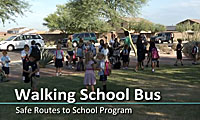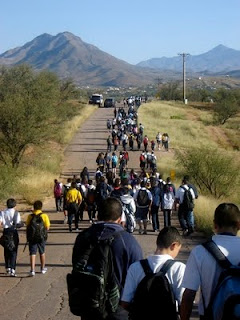ADOT plays a role in Safe Routes to School
ADOT plays a role in Safe Routes to School

Rico participate in a national walk-to-school event.
Between homework, heavy backpacks and pop quizzes, kids face enough challenges … walking to school should be the simplest part of the day.
But that’s not always the case, which is a reason why Safe Routes to School was created. The program takes aim at the growing epidemic of childhood obesity by making it a little easier and a bit safer for kids to ride a bike or walk to school!
ADOT administers the federally funded program in Arizona and annually distributes grant money to schools, districts, tribal communities, municipalities and nonprofit agencies who successfully outline projects that help remove the barriers preventing students from safely and conveniently walking or biking to school.
Something to think about …
According to the Federal Highways Administration’s Safe Routes to School website, in 1969 just about half of all students walked or biked to school. But today, fewer than 15 percent of all school trips are made by walking or bicycling.
That shift has led to more traffic congestion around schools and might be partly to blame for health issues like childhood obesity. According to a CDC report cited on the FHWA website, safety issues are the big concern for parents … traffic danger is often cited as a reason why their kids don’t bike or walk to school.
How SRTS works …
The program provides reimbursement funds for projects that remove obstacles like traffic danger and that encourage children to walk and bike to school.
Those projects can include things like the installation of bike racks, crossing signals, cross walks, sidewalks and bike paths. And, as long as the location is appropriate, traffic calming measures (think traffic circles and speed humps) can be funded, too.
Grants also are awarded for non-infrastructure projects – bike rodeos, “walk to school” days and other events are eligible for funds. Even incentives for students, like bicycle helmets or other prizes, are regularly funded by Safe Routes to School … anything to get students more interested in walking and biking!

This radar speed alert sign is an example of a smaller-scale SRTS project that can play a big role in helping to keep pedestrians safe.
Since the first grant cycle in 2007, ADOT has awarded approximately $10 million in SRTS funding. In just the 2011 cycle alone, funding was awarded for 21 projects!
According to ADOT’s SRTS Coordinator Brian Fellows, this year the SRTS Advisory Committee received grant requests for about three times the amount available.
But, Safe Routes to School doesn’t just fund projects. It also offers guidance to schools through a planning assistance program and a tribal planning assistance program. Fellows explained that schools can apply to get some no-cost assistance from SRTS consultants who will spend time at the school and will work with administrators to figure out what barriers are in place that prevent more students from walking or biking to school. There are also several grant-writing assistance program workshops offered through ADOT that are designed to help schools and organizations apply for Safe Routes to School grants.
“One of Safe Routes to School’s big successes and the reason why it has worked in Arizona and all the other states is because there are enough items on the menu, so to speak, and it is flexible enough that it offers options that work in every scenario,” said Fellows, adding whether it is a low-cost option or a project that entails a pretty big construction overhaul, it can be successful if the principles behind SRTS are followed.
The next SRTS $4-million grant cycle begins in September. Applications are due by Dec. 30 and individual grant requests can be made up to $400,000. For more information on the program and the numerous workshops offered, visit the Safe Routes to School website.

